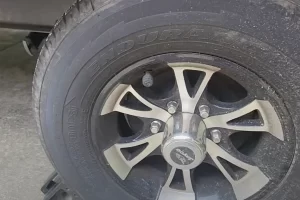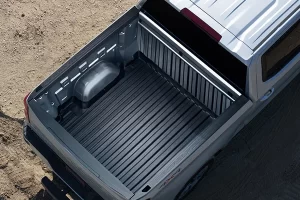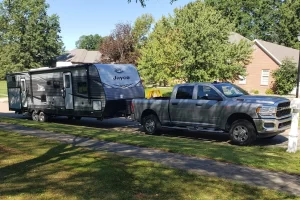Advice From Five Years of Weekend Warrior Hauling
If you’re here, I know exactly why—towing a travel trailer for the first time feels like driving a baby home from the hospital. And honestly, I recommend doing both in your life.
I still remember hauling our travel trailer home from the dealership. It wasn’t my first time towing something, but it was my first time pulling a 42-foot, house-on-wheels beast that felt like it weighed as much as a small planet.
Fast forward five years, and we’ve safely pulled our trailer across the region—from weekend trips to longer seasonal hauls. What follows is everything I’ve learned about how to safely tow a travel trailer. It’s not just what you’ll find in the manual—it’s the lived-in advice that makes all the difference.
1. Know Your Numbers
Before you hitch anything up, you need to understand what your truck and trailer are capable of—and more importantly, what they’re not.
I’ve seen too many travel trailer accidents that weren’t caused by debris, but by overloaded axles and underestimated weight. Payload and GVWR aren’t just technical specs—they are safety lines. Know them.
- GVWR (Gross Vehicle Weight Rating): The maximum loaded weight your trailer is built to handle.
- Tongue weight: Usually 10–15% of the trailer’s weight pressing down on your hitch.
- Payload capacity: How much your tow vehicle can carry, including passengers and tongue weight.
- Tow rating: Found in your vehicle’s manual—never guess or go by hearsay.
Pro Tip: Leave a safety buffer between what your trailer weighs and your truck’s max capacity. Just because your truck is rated to tow 12,000 pounds doesn’t mean it should on every trip.
2. Get the Right Equipment
Your towing setup makes a huge difference in both comfort and safety. I used to be skeptical about sway bars—until I had a semi pass me at 70 mph and felt the suction yank me toward it. Now I would never tow without them.
- Weight distribution hitch: Spreads the load across your axles, improving handling and braking.
- Sway control: Reduces fishtailing and improves control in wind and highway drafts.
- Brake controller: Required in many states, this syncs your trailer brakes with your truck.
- Extended mirrors: Add-ons that let you see past the sides of your trailer for safer lane changes.
What I Use: A weight distribution hitch with integrated sway control. It has saved me from more than a few white-knuckle moments.
3. Practice Driving and Backing
If you’ve never backed a trailer into a campsite, your first trip should start in an empty parking lot. I spent an hour before our first campground visit just practicing approach angles, mirror visibility, and how the trailer responds.
And here’s the thing: no matter how much you prepare, some campgrounds will challenge you. Tight access roads, trees positioned at the worst angle—there’s always a twist. More than once I’ve had to back in without hitting a tree that’s directly across from the campsite entrance.
- Drive wide around turns to avoid clipping curbs or signs.
- Give yourself extra braking space—trailers don’t stop on a dime.
- Always use a spotter if possible. Practice with your co-pilot beforehand and develop a system for clear communication—what they’re watching, what you can’t see, and how to adjust accordingly.
Marriage Tip: Nothing will test your relationship quite like backing into a site with your spouse spotting. Take it slow and laugh through it.
Final Word: Don’t rush. If you hold up traffic for a minute, so be it. Everyone at the campground is watching like it’s the Olympic finals, but they’ve all been in your shoes.
4. Road Safety Tips
Towing amplifies every part of driving—braking, turning, lane changing. You feel it all more.
- Tow/haul mode: Activates different shift points and provides better engine braking.
- Control your speed: I set my cruise at 58 mph because that’s where I feel safest and most stable.
- Monitor weather conditions: High winds and rain can make towing dangerous. Never be afraid to wait it out.
- Check tires: Do it before every trip—including both truck and trailer. Tires are your foundation.
Safety Extras to Carry:
- Tire pressure gauge
- Torque wrench
- Roadside reflectors or triangles
- Portable jack rated for your trailer weight
5. Build a Departure and Arrival Routine
Towing safely begins long before you hit the road.
- Do a full walkaround before every departure.
- Double-check that wheel chocks are removed.
- Test trailer lights, signals, and brakes.
- Confirm that sway bars and chains are properly attached.
- Secure everything inside the trailer.
Need a pre-built list? We’ve got you covered:
Travel Trailer Setup Checklist
Travel Trailer Teardown Checklist
Final Thoughts
Towing a travel trailer safely is all about attention and respect—for your equipment, for your route, and for the road conditions. The most experienced towers I’ve seen get into trouble are the ones who get too comfortable. That’s why I treat every single trip like I’m hauling a trailer full of fragile cargo.
Start slow. Drive smart. And remember—confidence comes with experience, and experience comes from doing it the right way, every time.




